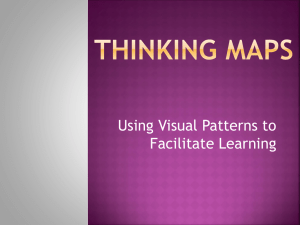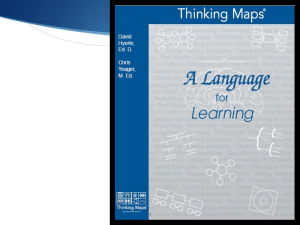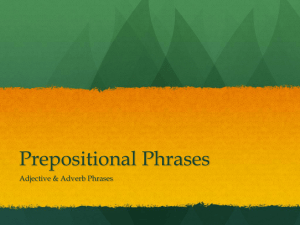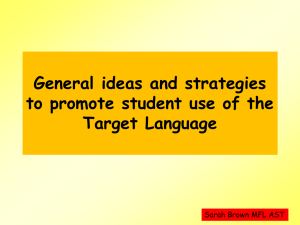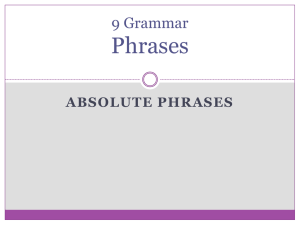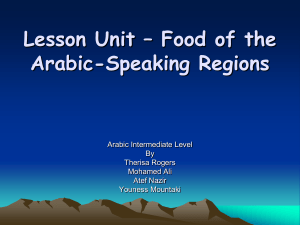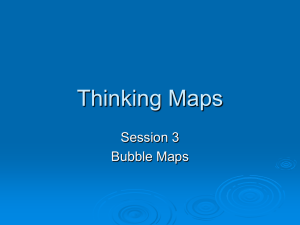Thinking Maps - chippewavalleyela
advertisement
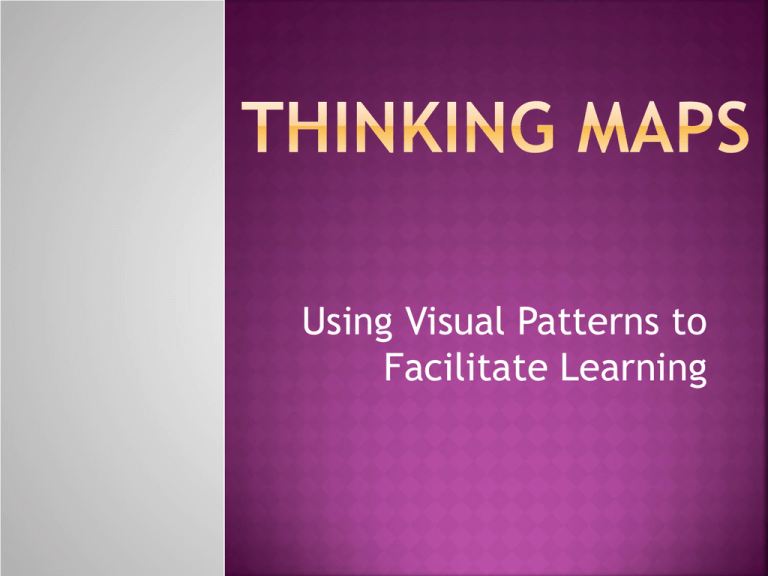
Using Visual Patterns to Facilitate Learning •Developed in 1988 by Dr. David Hyerle •8 Maps that are used by teachers and students for reading comprehension, writing process, problem solving and thinking skills •Each map is based on a cognitive skill such as comparing and contrasting, sequencing, classifying, and cause-effect reasoning •Can be utilized individually or in various combinations to form a common visual language for students and teachers at all grade levels, in all subjects •Used to improve the basics of reading, writing, and mathematics as well as for problem solving and the development of higher order thinking skills •Used across the United States as well as Canada, the United Kingdom, Australia, New Zealand, Brazil, Egypt, Ethiopia and other countries •Supported by several published articles and brain research What are Thinking Maps? Thinking Maps are a common visual language for learning. They have a consistent design, but are highly flexible. Each map is based on a thinking process. With consistent use, the brain develops a pattern that connects the process to a specific Thinking Map. Why use Thinking Maps? Research shows that consistent use of Thinking Maps increases I.Q. scores, S.A.T. scores, and reading & writing scores. Thinking Maps help students become independent, reflective, life-long problem solvers and learners. What are the eight Thinking Maps? The eight maps include the Circle Map, Bubble Map, Double Bubble Map, Tree Map, Brace Map, Flow Map, Multi-Flow Map, and the Bridge Map. Students learn more effectively and more efficiently Objectives are covered in less time with greater retention Thought processes are represented similarly throughout the curricula Schools also promote integrated thinking and interdisciplinary learning Teachers can easily gauge student knowledge prior to a specific lesson Student performance can be tracked over time Students gain effective tools to use across their academic and working careers Lifelong thinking tools Thinking Process: Defining in Context Key Question: How are you defining this thing or idea? Key Words and Phrases: List, define, tell everything you know, brainstorm, identify, relate prior knowledge, describe, explore the meaning Design: the topic is in the middle, smaller circle. Everything you know about the topic is in the larger circle. A box, that may be included, around the entire map is a “Frame of Reference” that is used to answer the question “How did I learn this?” (The frame of reference can be used around any of the maps Common Uses: Brainstorm for writing, used as a starting point during the prewriting stage, defining words, identifying audience and author’s point of view Writing Mode: Point of View Essay Thinking Process: Describing Qualities; Characterization Key Question: How are you describing this thing? What adjectives best describe it? Key Words and Phrases: Describe, use vivid language, describe feelings, observe using the five senses Design: The topic being described is in the center bubble. The outer bubbles contain adjectives and adjective phrases describing the topic. Common Uses: Describing things, identifying qualities, character traits, attributes and/or properties of things. The Bubble Map is a tool for enriching students’ abilities to identify qualities and use descriptive words. Writing Mode: Descriptive Writing Thinking Process: Comparing and Contrasting Key Question: What are the similar and different qualities of these things? Key Words and Phrases: Compare/contrast, discuss similarities and differences, prioritize essential characteristics, distinguish between, differentiate Design: In the center circles are the words for the two things being compared and contrasted. In the middle bubbles, use terms to show similarities. In the outside bubbles, describe the differences. If there are too many similarities or differences, students should prioritize and keep only the most important. Common Uses: A tool for comparing and contrasting two things. Writing Mode: Comparison Essay Thinking Process: Classifying Key Question: What are the main ideas, supporting ideas, and details in information? Key Words and Phrases: Classify, sort, group, categorize, give sufficient and related details Design: The category name is on the top line, subcategories on the second level, details under each subcategory Writing Mode: Persuasive Essay Thinking Process: Part to whole relationship Key Question: What are the parts and subparts of this whole physical object? Key Words and Phrases: Part of, take apart, show structure Design: On the line to the left, the name of the whole object is written. On the lines within the first brace, list the major parts. The subparts are listed in the next set of braces. Common Uses: Used to analyze physical objects. Can be used with anatomy, boundaries in geography, parts of tangible objects. It is for parts only, for “types” of things, a Tree Map should be used. Writing Mode: Technical Writing Thinking Process: Sequencing Key Question: What happened? What is the sequence of events? What are the sub-stages? Key Words and Phrases: Sequence, put in order, order, recount, retell, what happens next, cycles, patterns, describe processes, describe change, solve multi-step problems Design: Each stage of the event is in the larger rectangles. The substages are in smaller rectangles below the larger ones. Not all Flow Maps will have sub-stages. Common Uses: Can be used to plot a story, show historical events in sequence, sequence paragraphs for writing, steps in problem solving in math, identifying stage of a life Writing Mode: Narrative Writing Thinking Process: Cause and Effect; Problem-Solution Key Question: What are the causes and effects of this event? What might happen next? Key Words and Phrases: Causes and effects, discuss consequences, what would happen if, predict, describe change, identify motives, discuss strategies Design: The event is in the center rectangle. On the left side, causes of the event. On the right side, effects of the event. Common Uses: Used to show and analyze cause and effect relationships. It can also be used with only part of the map showing, such as predicting outcomes. Writing Mode: Prediction; Cause and Effect Essay Thinking Process: Sequencing Key Question: What is the analogy being used? Key Words and Phrases: Identify the relationship, guess the rule, interpret symbols Design: On the far left line, write the relating factor. On the top and bottom of the bridge, write in the first pair of things that have this relationship. On the right side of the bridge, write the second pair with the same relationship. The line of the bridge represents the relating factor between the pair of things. Common Uses: Identifies similarities between relationships. The relating factor answers “How are they related?” The Bridge Map should be able to be read as a complete sentence. Writing Mode: Reasoning by Analogy What is the Frame of Reference? The Frame of Reference can be used with any of the eight maps. It provides an area for students to synthesis information, think more deeply, and support their reasoning. What goes into the Frame of Reference? •How do you know what you know? •Elaborate with Extras (E’s) ~or~ Interpret the Information (I’s) Elaborating with the Extras (The E’s) Interpreting Information (The I’s) Include your own personal experiences. What is the importance of this information? Use supporting examples from the text. What inferences can be made? Incorporate evidence from text/world. What influences affect this information? What historical/literary events support your ideas? Include further explanation on the subject. Elaborate on your thinking and reasoning. What expert “opinions” can you find as support? Include excitement or personal feelings about the topic. Examples of each map grades K-6 http://fdlrs.brevard.k12.fl.us/ThinkingMaps/default.html Newsletters devoted to each Thinking Map http://www.kcclc.org/thinkingmaps2?print-friendly=true Chippewa Valley ELA Website http://chippewavalleyela.pbworks.com

